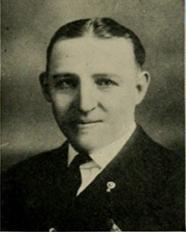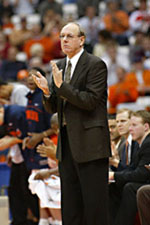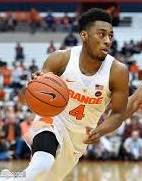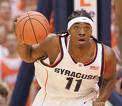In 2007, OrangeHoops inducted its charter class into the OrangeHoops Hall of Fame: Dave Bing, Derrick Coleman, Sherman
Douglas, Vic Hanson, and Pearl Washington. The next ten years saw the
addition of Billy Owens (2008), Billy Gabor (2009), Lawrence Moten (2010),
Louis Orr (2011), Roosevelt Bouie (2011) John Wallace (2012), Rony
Seikaly (2013), Vinnie Cohen (2014), Etan Thomas (2015) and Joe Schwarzer
(2016). So the list now stands at 15. Another year has passed, and now it
is time for the 2017 inductee.
I established my rules for the OrangeHoops Hall of Fame back in
2007 and you can catch up on them here. 2017 does have seven new eligible candidates (using the
fifteen year rule): DeShaun Williams, Preston Shumpert, James Thues, Billy
Celuck, Ethan Cole, Mark Konecny and Greg Davis.
DeShaun Williams was a controversial guard for the Orangemen. He was definitely talented, with court
quickness and the ability to get to the hoop.
He was a starter his sophomore and junior seasons, and was named to the
Big East Third team his junior year. He
was also noted for being a selfish player, and had personal problems with his
teammates, on and off the court. He was
academically ineligible after his junior season, and would transfer to Iona.
Williams would score 1,136 points at Syracuse.
Preston Shumpert was one of the best three point shooters in
Syracuse history, with terrific range.
He was a streaky shooter and carried the Orangemen to many victories,
seven times in his career scoring 30+ points in a game. He would be named to the Big East First Team
both his junior and senior seasons, averaging 20.7 points per game his senior
year. He was not a strong defensive
player, and there were questions about his temperament, particularly related to
issues with DeShaun Williams. Shumpert
is currently the 8th all time leading scorer at SU.
James Thues was a short stocky point guard with excellent ball
handling and passing skills. He was also
quite adept at stealing the ball from the opponents. A true point guard, Thues
was not much of a shooter and rarely scored. He would share time starting at
the point his sophomore season with DeShaun Williams. Thues would leave Syracuse after his
sophomore year, transferring to Detroit-Mercy.
Billy Celuck was a 7’ center who saw limited playing time his
first two seasons at Syracuse, totaling 132 minutes. He would split time at center his junior year
with Jeremy McNeil, averaging 4.3 points per game. His senior year he would see diminished
playing time as McNeil improved and freshman Craig Forth arrived.
Ethan Cole transferred to Syracuse from the University of New
Hampshire, and played two seasons. Cole
would have limited playing time his junior season at Syracuse. He was expected
to play more in senior year, and started a couple of games. However, he lost
his starting position to Hakim Warrick, and then an injury ended his season,
and career, after 8 games that year.
Greg Davis was a forward for one season. He saw limited playing time his freshman year
with only 27 minutes, and redshirted his sophomore season. He did not like his
prospects for playing time after his sophomore year, and transferred to North
Carolina A&T.
Mark Konecny was a reserve forward for one season. He would play only two games for the
Orangemen before leaving for personal reasons.
Of this year’s candidates, Preston Shumpert would make my top 10
list of candidates.
I think this year’s viable top 10 candidates come down to the
following, listed chronologically: Lew Castle, Lew Andreas, Jon Cincebox, Jimmy
Lee, Rudy Hackett, Leo Rautins, Rafael Addison, Stephen Thompson, Jason Hart
and Preston Shumpert.
Castle was
a two time All-American at Syracuse, and was captain and leading scorer of
Syracuse’s only undefeated team, the 1913-1914 squad that went 12-0.
Andreas coached
Syracuse basketball for 27 seasons, including the 19-1 1925-1926 squad that was
awarded the Helms Foundation National Championship. He had a career record of
358-134, and he was the Syracuse Athletic Director for 28 years (1937-1964).
Cincebox was
on the best rebounders in Syracuse history (in an era when rebounding numbers
were admittedly high). He helped Syracuse to the NCAA Elite Eight in
1956-1957, as the dominant big man for the Orangemen.
Lee was
a clutch shooter with terrific perimeter range, and outstanding free throw
shooting ability. He was able to use his shooting ability to set himself up as
a solid passer. Lee's 18 foot jumper with five seconds remaining led the
Orangemen to beat heavily favored North Carolina, as the Orangemen eventually
moved on to their first NCAA Final Four. Lee would end up making the
All-Tournament team for his outstanding performances.
Hackett was
a powerful forward who could run the court well. He was a great rebounder and
terrific scorer near the hoop. He led the Orangemen in scoring his senior
year and helped lead Syracuse to its first Final Four in 1975.
Rautins was
a terrific ball-handling forward with a nice shooting touch, solid rebounding
and scoring skills. He is most well-known for his game winning tip in basket to
win the Big East Championship in triple overtime against Villanova in
1981. Rautins also recorded two triple-doubles in Big East action.
Addison was
a gangly small forward who earned a reputation for being one of the most
underrated players in the country. He possessed an excellent mid range
jump shot, was decent passing the ball, and was a solid free throw shooter. He
led the team in scoring his sophomore and junior seasons. He moved to
shooting guard his senior year, and his 6’7” height helped with the mismatches.
Unfortunately a leg injury impacted his effectiveness the second half of the
season.
Thompson was
an explosive swingman, with incredible quickness and vertical leap, and
excellent defensive skills. He was extremely adept at playing above the basket
though he was only about 6'2". He teamed with Sherman Douglas to perfect
the alley-oop basket. Thompson was an extremely proficient scorer,
despite the fact he was a terrible perimeter shooter.
Hart was
a speedy defensive point guard, and a four year starter. He was a decent
ball handler, and finished his career as the number two assist man all time at
Syracuse. He was much better on the defensive end, and would finish as SU's
all-time leader in steals. Hart would have a 9 year career in the NBA,
mostly as a backup guard.
All are worthy players, and tough selections to make. I
designed my selection rules to make it tough; the Hall of Fame should be the
'best of the best', and I would rather have a line of worthy players outside
the Hall of Fame, than cheapen it by having lessor players included.
Ten very good candidates, and a couple of those players are among
my all-time personal favorites. My 2017 inductee is Lew Andreas.
Andreas was SU’s winningnest basketball coach before Jim Boeheim
arrived. He coached 26 seasons at
Syracuse, and had several outstanding seasons. His 1926 squad, led by Hall of
Famer Vic Hanson, went 19-1 and was recognized by the Helms Foundation as the
National Champions. In the 1930s, his Reindeer Five squad ran opposing teams
off the
court, and he helped transition the team (and game) to a faster pace
game. Andreas led SU to its first post season action in 1946 going to the NIT,
and again in 1950.
Andreas was a proponent of playing multiple players, and shuffling
his starting lineups game to game.
Against Fordham in 1939, Andreas played 21 different players in the
game.
He was the Syracuse Director of Physical Education and Athletics
from 1937 to 1964. During that time, he
saw the basketball program develop into an NCAA power, the football program
reach elite status with a national championship in 1959, and the lacrosse program
became one of the pre-eminent programs in America.












